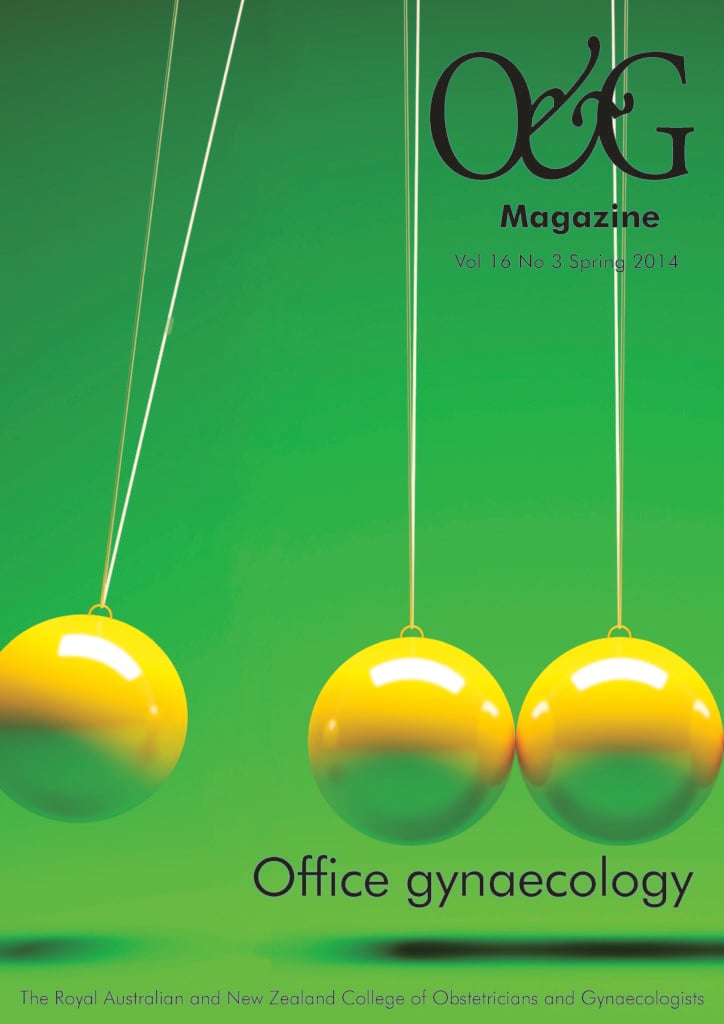According to a recent survey, 97 per cent of Australian women want to be asked about alcohol use during pregnancy.
A new Australian public-health initiative, Women Want to Know, was recently launched with RANZCOG involvement. It was developed by the Foundation for Alcohol Research and Education (FARE) with funding from the Australian Government. The campaign encourages health professionals to discuss the risks of consuming alcohol during pregnancy with women who are pregnant or planning pregnancy. RANZCOG has also developed an online-learning course that attracts CPD points.
Women Want to Know promotes the 2009 National Health and Medical Research Council’s Australian Guidelines to Reduce Health Risks from Drinking Alcohol (NHMRC Alcohol Guidelines). These are carefully worded and specify ‘Maternal alcohol consumption can harm the developing fetus or breastfeeding baby’, furthermore: for women who are pregnant or planning a pregnancy, not drinking is the safest option; and for women who are breastfeeding, not drinking is the safest option.1
In developing the campaign, a survey was undertaken to establish current practice and awareness of the NHMRC Alcohol Guidelines by health professionals. Only the results from obstetricians and gynaecologists are reported here. Between August and November 2013, an online survey, conducted by IPSOS Social Research Institute, was distributed by RANZCOG. In total, 209 obstetricians and gynaecologists (respondents) completed the survey, receiving one CPD point for their participation. The results were as follows:
- The majority (85 per cent) of respondents believed that a pregnant woman cannot drink any alcohol without risk to the fetus, 11 per cent said that a pregnant woman could consume one or two standard drinks per day and four per cent said they did not know.
- 24 per cent of respondents said that they had never heard of the NHMRC Alcohol Guidelines; 29 per cent had heard of them, but were unfamiliar with their content. Only seven per cent said they were very familiar with the content.
- 77 per cent of respondents indicated they discuss alcohol consumption with women who are pregnant for the first time, but only 62 per cent discuss alcohol with a woman who was pregnant for the second or subsequent time.
- When asked about their concerns in discussing alcohol, 16 percent said they were concerned about the woman’s comfort and 16 per cent said they were concerned about a lack of referral options available. However, 51 per cent of respondents also said they were unfamiliar with referral pathways available to them to assist pregnant women experiencing problems with alcohol.
Respondents were also asked about the advice they provided to women about alcohol consumption during pregnancy, 74 per cent recommended abstinence, but other statements included:
- no more than two drinks per day;
- avoid spirits;
- avoid excessive use;
- no alcohol in first trimester;
- keep third trimester alcohol to an absolute minimum;
- permitted to have one glass of wine with main meal, usually with dinner once per day as a maximum;
- one drink a day or five a week is acceptable, moderation is the key, never be unable to legally drive, and
- should be safe with less than nine drinks per week.
These responses demonstrate the range of messages that women receive. However, the NHMRC Alcohol Guidelines clearly state that no alcohol consumption is the safest option for women who are pregnant, planning pregnancy and breastfeeding. These guidelines are supported by evidence from systematic reviews and prospective cohort studies. No studies have definitively established a safe level of alcohol consumption and no level of alcohol consumption has been found where damage to the fetus will not occur.2,3 It is known that at a cellular level, even very low levels of alcohol exposure may cause damage.4 This does not mean that low levels of exposure have been proven to damage the fetus, rather reflecting the uncertainly and the difficulty in proving such a link in population studies. It is important to reassure women and provide ongoing education if there is inadvertent exposure to alcohol.
One-in-five Australian women continue to drink after becoming aware of their pregnancy.5 Therefore, health professionals need to provide women with clear advice that no alcohol consumption is the safest choice during pregnancy.The course on alcohol and pregnancy is available at www.climate.edu.au/login/index.php and a range of resources that can be used in practice, including leaflets for women, can be ordered from www.alcohol.gov.au .
References
- NHMRC. Australian Guidelines to Reduce Health Risks from Drinking Alcohol. 2009. Commonwealth of Australia. Canberra.
- O’Leary C, Nassar N, Kurinczuk J and Bower C. The effect of maternal alcohol consumption on fetal growth and preterm birth. BJOG 2009; 116:390-400.
- Henderson J, Gray R, Brocklehurst P. Systematic review of the effects of low-moderate prenatal alcohol exposure on pregnancy outcomes. BJOG 2007;114 (3):243-252.
- Alfonso-Loeches S, Guerri C. Molecular and behavioral aspects of the actions of alcohol on the adult and developing brain. Critical Reviews in Clinical Laboratory Sciences 2011. 48 (1): 19-47.
- Callinan S and Room R. Alcohol consumption during pregnancy: Results from the 2010 National Drug Strategy Household Survey. 2012 Centre for Alcohol Policy Research and FARE, Canberra.






Leave a Reply